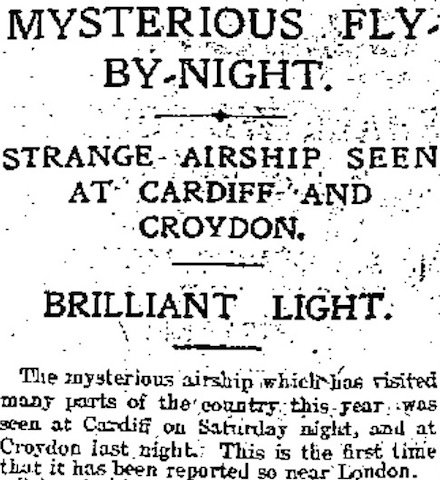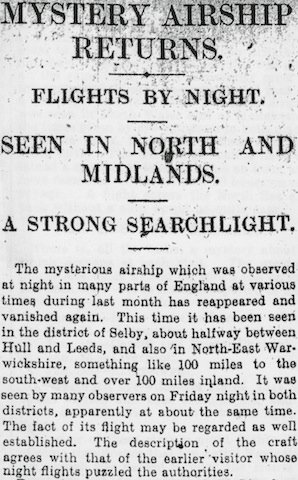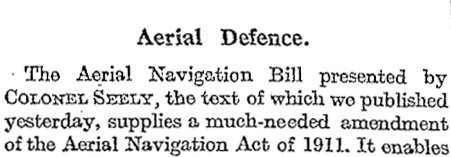
No less than three new phantom airship reports in today’s papers: two from South Wales, which is fast becoming scareship central, and one from Croydon in the south-east of England.
To take the last airship first, as the Daily Express says, ‘This is the first time that it has been reported so near London’ (p. 7, above). Even so, the Express did well to get an interview with one of the witnesses, given that it happened only last night:
‘An airship passed over here at a quarter to nine [on 2 February 1913],’ said Mr. Trubshawe, of Fairfield-road, East Croydon, to an ‘Express’ representative last night. ‘It came from the south-east, and moved overhead, disappearing rapidly to the north-west.
‘I could not make out the exact shape of the envelope, but it must have been an airship of great size. Rays of light issued from it to the right and left, and also downward. There was quite a considerable volume of light altogether.’
‘Others’ also saw the airship, which was said to be ‘moving with the wind’. The Liverpool Echo relays the Express‘s article (p. 5), while the Globe just notes that ‘a number of people’ at Croydon saw an airship last night (p. 12).
The Globe does provide a slightly fuller account of an airship or airships seen in Glamorganshire both last night and on Saturday night:
Police-constable Church, of the Glamorgan County Constabulary stationed at Aberavon, states that last night [2 February 1913] he watched the aircraft for an hour. Towards midnight on Saturday [1 February 1913], a stud groom at Green Meadow saw the airship, with a light at the stern, coming from the direction of Cardiff, and travelling in a westerly direction.
Aberavon is on the coast near Swansea, while Green Meadow (or Greenmeadow) is an estate near Tongwynlais, in the Taff Valley. It would appear that this latter sighting, along with the single sentence in The Times noting that ‘an airship was again seen’ over Glamorgan (p. 6) and the longer (but still not very detailed) report in the Daily Mail (p. 5), is the same as that reported by the Standard (p. 9) as taking place ‘on Saturday night’ [1 February 1913]:
The airship was seen at 10.45 p.m. going over the Taff Valley, four miles north of Cardiff. The night was clear, and a good view of the craft was obtained by several people. After going up the valley nearly to Walnut Tree Bridge the airship turned in a westerly direction, and was last seen going towards Cross Vein.
‘Telephonic communication’ was established with Neath, presumably lying in the direction the airship was heading; ‘observers there were speedily on the look-out, but nothing was seen’. Once more it is Captain Lindsay, the Chief Constable of Glamorganshire, who is keeping the press informed of the latest airship sightings (certainly for the Taff Valley one, according to the Standard, and presumably for the Aberavon one, since one of his policemen was involved). He is evidently still very interested in the mystery after his own sighting a couple of weeks ago.
Several of these accounts come with interpretations attached. The Globe and says that ‘the latest theory’ (proposed by whom?) ‘is that the airship is making trial trips from some point on the Devonshire moors’ (p. 12). The Standard offers much the same, in speculating about where the Taff Valley airship went (p. 9):
The supposition is that it must have crossed the Bristol Channel to the Exmoor district, which, it is suggested, being an unfrequented region, would be likely to be chosen by any persons desirous of experimenting in the construction of airships. It is further to be noted that on more than one occasion the airships seen in South Wales have passed out of sight over the Bristol Channel in this direction.
Whereas the Express, after updating its list of sightings to date, adds that the ‘airship which startled people at Sheerness at the end of last year was stated afterwards to be the German airship Hansa’: with a speed of 50 miles per hour (a slight exaggeration) and a range of 1000 miles, ‘It could cross the North Sea in a few hours with a favourable wind’ (p. 7).
![]() This work is licensed under a Creative Commons Attribution-NonCommercial-NoDerivatives 4.0 International License.
Permissions beyond the scope of this license may be available at http://airminded.org/copyright/.
This work is licensed under a Creative Commons Attribution-NonCommercial-NoDerivatives 4.0 International License.
Permissions beyond the scope of this license may be available at http://airminded.org/copyright/.






Just a few years early for Croydon Airport (which didn’t take airship traffic, so that doesn’t help!).
Fairfield Road East Croydon isn’t that far from what became Croydon Airport, in fact. [Your ex-Croydonian correspondent points out.]
Pingback: Tuesday, 4 February 1913
Local knowledge! The ‘Mr. Trubshawe, of Fairfield-road, East Croydon’ is likely Vyvyan Trubshawe, of 21 Fairfield Rd, the father of Second Lieutenant Eric Trubshawe killed in action on the Western Front four years after his father’s airship sighting to the very day.
Pingback: Friday, 7 February 1913
Pingback: Saturday, 8 March 1913